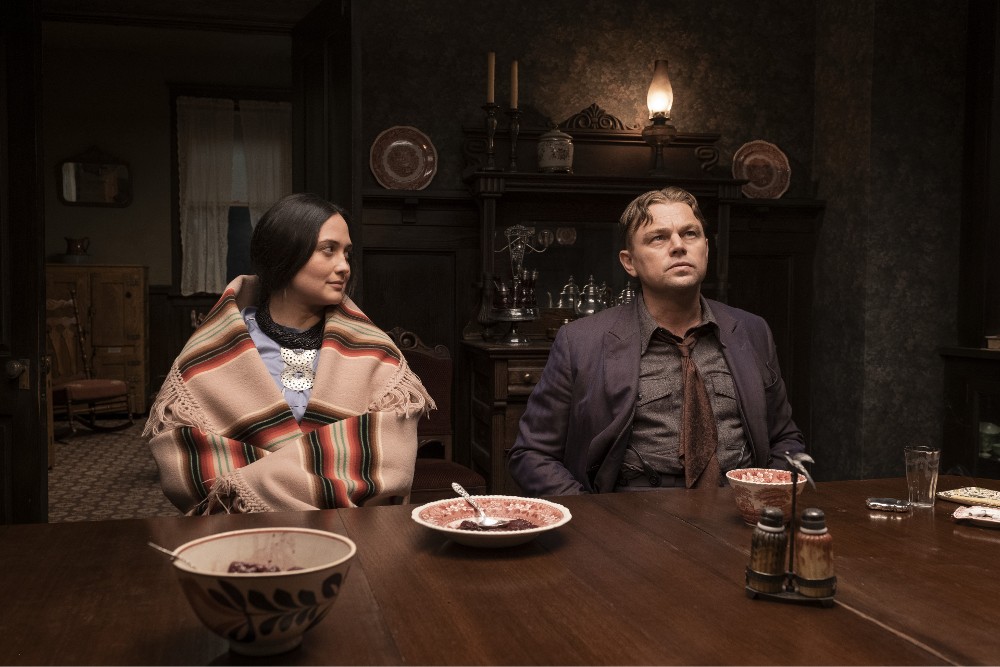
There is a reason Martin Scorsese will always make better movies than just about any other living person—his love of cinema transcends our own. In his latest magnum opus, Killer of the Flower Moon, Scorsese returns to tiptop shape with another epic true crime story that is as much about American History as past projects from Gangs of New York to Wolf of Wall Street. In his tenth and sixth collaborations with stars Robert DeNiro and Leonardo DiCaprio, respectively, the greatest living American director remains at the top of his game. He harkens to a horrific time in the past—and harkens horrifically to the idea that Great American Cinema may be dying with him, too.
Killers of the Flower Moon is based on the novel of the same name, in turn based on the shocking murder spree of Osage American Indians in Oklahoma in the 1920s. DeNiro stars as crime boss William King Hale and Leo is his dopey, cruel and subservient nephew Ernest Burkhart. Newcomer Lily Gladstone is the star in a spectacular turn as Ernest’s aggrieved wife, Mollie. The film opens as the Osage are granted ownership rights over the oil recently discovered in their Oklahoman lands. But, as in so many films in the pantheon of cinema, the black tar may as well be synonymous with blood. Their instant riches are the natural target for grifters, extorters, and, ultimately, murderers, led by a plot hatched by Hale.
Scorsese’s filmography is stunningly vast and varied, but for better or for worse, he is associated with the mob films that netted him most recognition, from Goodfellas to The Departed. Killers of the Flower Moon is without question a mob story, one centered not on the drug trade but on a substance that has proven just as addictive to the American lore for as long as opiates and other narcotics have. And while most of the great director’s work had touched upon different episodes in American history, none other than maybe Gangs had happened upon another tortured American relationship: that with race. In Killers, however, the criminal, inhumane disregard for Native Americans is on full display, though it is but one of the many threads that makeup the rich tapestry of this complex, compelling, and riveting movie.
Signature Marty touches gleefully elevate Killers to the pleasurable film experience that it is. Characters are bombastic and dull, with Hale and his cronies at times caricatures of themselves. Brendan Fraser, John Lithgow, and Jesse Plemons make third act appearances as defense lawyer, prosecutor, and FBI gumshoe, all adding to the effectively clownish nature of the acting. The kudos in that regard, though, belong to Leo, who knocks it out of the park with a top three career performance as the manipulable but “in love” Ernest; to DeNiro, who plays it straight into the banality of evil in ways that few actors can accomplish; and to Gladstone, who provides the film’s emotional core. It is nothing short of remarkable that Scorsese can mix this wildly varying acting styles and portrayals into a film that is tonally exact and fires on all cylinders. In anyone else’s hands, such dissonant approaches to the characters would have perhaps destroyed the narrative.
Also notable are a taut script adapting the novel, courtesy of Scorsese and the experienced adapter of sweeping novels, Eric Roth (Dune). The long story ambulates from episode to episode seamlessly (here, too, three-time Oscar winner Thelma Schoonmaker deserves props for her editing). The layers of Hale’s plot may be thick and the characters in the drama endless, but Scorsese is a masterful storyteller, using the screenplay and editing to exacting success.
Below the line, cinematographer Rodrigo Prieto and film composer Robbie Robertson (in his last complete project) shine. Prieto with a steely-eyed lighting that gravitates easily from the sunny countryside to the dark of night. Robertson with a moody, persistent drumbeat that’s almost ironic or sarcastic, like so many other signature Scorsese soundtracks before this one. The production design and costumes are also top notch—again, everything works and nothing is left to chance.
It is worth returning, as Killers of the Flower Moon does in the closing scenes, to Scorsese’s love of cinema. His love of film is, in reality, a deep appreciation for Americana, for American history, in the last and prior centuries. Where most filmmakers would have chosen title cards to tell of “what happened next,” Scorsese sets up a live newsreel type orchestra that is both delightful but also remarkably clever. He pulls the curtain behind the magic, the make belief of cinema, while paying homage to bygone storytelling.
So much of our American story is gone, so much of our way of telling stories—certainly on the big screen—is evaporating. Scorsese does not, of course, lament the disappearance of the brutality of the past. All the contrary, he bemoans it with a powerful coda. He laments the tragedy of the past together with the grotesque present, which tragically forgets the past. To do all of this through the vehicle of a very long film about murders in Oklahoma in the 1920s is an astounding accomplishment for that genius that is, Mr. Martin Scorsese.
Grade: A
Killers of the Flower Moon Premiered at the Cannes Film Festival and comes to theaters Friday, October 20, 2023, courtesy of Apple and Paramount
Twitter: @jdonbirnam
Instagram: @awards_predix





